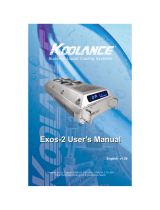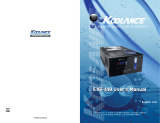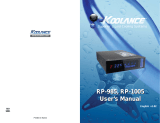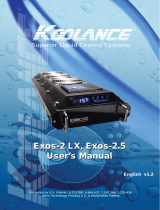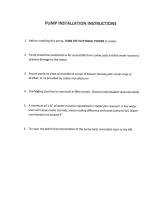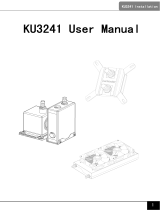Page is loading ...

Protected by U.S. Patents 6,664,627; 6,313,990; 6,234,240; 5,731,954
Other Technology Pending U.S. & World-Wide Patents
Superior Liquid Cooling Systems
®
English v1.00
ERM-3K4U
User’s Manual
ERM-3K4U
User’s Manual

i
User Manual
This User Manual is updated regularly. Please be sure to check our support page for a newer
version of this guide: www.koolance.com/support
GENERAL PRECAUTION
Please read this manual carefully before beginning the installation of your Koolance system.
This manual assumes the user has basic experience in building and confi guring computer
systems. Information referring to traditional hardware assembly is intentionally brief.
ABOUT SIGNS
Throughout this document, critical information is highlighted in gray-colored boxes. The
following symbols are intended to prevent you from any situation which may cause
personal injury and/or damage to equipment:
!
WARNING: Indicates a potentially hazardous situation which, if not avoided,
could result in personal injury or be life-threatening.
!
CAUTION: Indicates a potentially hazardous situation which, if not avoided,
may result in damage to equipment.
PROHIBITED: Indicates a prohibited action.
PROHIBITED USE
This product is designed, developed and manufactured as contemplated for general use,
including without limitation: general offi ce use, personal use and household use, but is not
designed, developed and manufactured as contemplated for use accompanying fatal risks or
dangers that, unless extremely high safety is secured, could lead directly to death, personal
injury, severe physical damage or other loss, including without limitation: nuclear power core
control, airplane control, air traffi c control, mass transport operation control, life support,
or weapon launching control. If these products are used in such hazardous environments,
Koolance Incorporated does not warrant them.
TRADEMARKS
The Koolance name and logo, and the Exos name and logo are trademarks or registered trademarks
of Koolance, Inc. Other company and product names used in this publication are for identifi cation
purposes only and may be trademarks or registered trademarks of their respective companies.
COPYRIGHT
All rights reserved. Copyright (C) Koolance, Incorporated 2004

ii
WARNING: The Koolance liquid & coolant pack contain chemicals
which may be harmful or fatal if swallowed. KEEP THIS AND ALL
DANGEROUS CHEMICALS OUT OF THE REACH OF CHILDREN. If
ingestion has occurred, seek medical attention immediately. Give two
glasses of water. Do not induce vomiting. In the case of eye contact,
fl ush eyes immediately with water for 15 minutes. Remove contact
lenses. Call a physician if irritation persists. Some individuals may
have an allergic skin reaction with the solution, although generally mild.
Avoid contact as much as possible, and wash exposed area with soap
and water for at least 15 minutes. If irritation persists, or if contact has
been prolonged, get medical help. For further information, please visit
our website at: www.koolance.com
CAUTION: Koolance Incorporated can not be held responsible for any
damage to your system due to misconfi guration or incorrect installation.
If there is any point of installation that you do not understand, please
contact our Technical Support Staff at: [email protected], or visit
our website at: www.koolance.com/support
CAUTION: Liquid cooling systems are not yet universally supported by
hardware manufacturers. In some situations, adding liquid coolers and
other components to computer hardware might void the manufacturer’s
original warranty. Installation of the device is ultimately done at the user’s
own risk. If you have any specifi c questions on warranty coverage,
please contact your component or computer manufacturer.
!
KOOLANCE CONTACT INFORMATION
Koolance Inc. (USA)
Address: 2840 West Valley Highway North, Auburn, WA 98001 (USA)
Telephone: +01 253-893-7551
Sales Email: [email protected]
Tech Email: [email protected]
Web: www.koolance.com
!
!

iii
User Manual
Table of Contents
Introduction 1
ERM-3K4U System Diagram .......................................................................... 4
LED Display Panel .......................................................................................... 5
Connecting ERM-3K4U Systems 8
Reservoir & Pump Connections ...................................................................... 9
Power Connection ........................................................................................... 9
Cooler & Tubing Confi guration ...................................................................... 10
Connecting Hoses ......................................................................................... 12
Disconnecting Hoses .................................................................................... 13
Hose Lengths ................................................................................................ 14
Filling & Maintenance 16
Testing & Filling ............................................................................................. 17
Adding Coolers & Maintenance .................................................................... 19
Troubleshooting ............................................................................................ 20
Limited Warranty ........................................................................................... 23

iv
ERM-3K4U Series Systems:
- ATX power jumper wire
- liquid coolant mixture with funnel
- liquid tubing
- user manual
- rear shutoff quick disconnect nozzles
Included Hardware
fl at-head screw driver
phillips-head screw driver
pliers
scissors
Required Tools
During installation, you may need the following tools:
long-nose pliers

1
User Manual
Chapter1
Introduction

2
Congratulations on your purchase of a Koolance system!
As the most sophisticated product of its kind, Koolance offers many unique
features found nowhere else in the realm of computer cooling. In addition, you
can expect to enjoy all of the advantages that water-cooling technology brings
with it.
Advantages of Water Cooling
Water transfers 30 times faster, and holds over 4 times more heat than air.
With this thermal conductivity and specifi c heat capacity, it’s easy to see why
liquid cooling is getting a lot of attention from hardware manufacturers.
Heat-producing devices in a typical computer are cooled by air. Generally, this
involves mounting a heat sink and fan to each component. For example, heat
generated from your CPU (or other heat source) is transferred into a metal heat
sink, where a fan blows air across its wide surface area.
While altering a heat sink’s size and makeup can improve the effectiveness,
it is still limited because air absorbs and transfers heat very slowly. To help
compensate for this, the fan is often run at a higher speed. Many people
have therefore come to equate high performance with high noise. As systems
continued to be upgraded, the required heat sinks simply got larger and louder.
Liquid cooling greatly reduces the noise issue. A larger amount of heat is
withdrawn from the components more quickly, and less airfl ow is required to cool
them.
The heat exchanger is also located remotely from heat-producing devices,
so airfl ow can be controlled. This considerably reduces dust accumulation on
sensitive hardware and can result in a cleaner overall system.
Advantages of Koolance Systems
Koolance was the fi rst company to offer fully-integrated, consumer-level PC liquid
cooling systems to the world-wide market. Our products are designed and built
to look and operate professionally. You will not need power tools or a tape
measure to install your Koolance system, and it should even be less diffi cult than
assembling your own computer.
Koolance offers liquid coolers for every major hardware device. Providing
enormous fl exibility, you can customize your system to fi t your specifi c needs—
cool dual processors in a server, multiple hard drives in a RAID confi guration, or
add dual video cooling to a gaming rig.
Introduction

3
User Manual
Every Koolance system includes built-in hardware safety features. Our
proprietary power control board constantly monitors liquid temperature, sounding
an alarm if it should get too high, and even turning-off your computer if you are
not there to do so.
But Koolance’s innovations extend beyond just cooling features. Our safe,
patent-pending CPU Retention Clip places even pressure across the CPU,
protecting the chip and simplifying installation. There’s even a ratcheting tension
screw for precise contact pressure.
Finally, Koolance systems allow coolers to be easily exchanged and upgraded
to address future hardware compatibility.

4
Introduction
ERM-3K4U System Diagram
Reservoir
Rear Radiator
Cooling Fans
Radiator
(Primary Heat
Exchanger)
*Inlet / Outlet Nozzles
& Power Switch for:
Radiator - The primary heat exchanger is the main cooling element, and provides
high thermal dissipation in a relatively small area. Inside, an aluminum mesh
(louver fi n) is webbed between horizontal liquid paths.
Reservoir & Pump - The coolant tank is transparent for easy liquid-level monitoring
throughthe top or side windows. It is fi lled through a small metal plug on the top
side.
Flow Meters - Each pump is paired with a fl ow meter, viewable through the top
reservoir window. These are provided for the visual diagnosis of pump issues.
Lighting for the fl ow meters can be toggled with the rear Illumination Switch.
Pump(s)
Pump 1 Pump 2 Pump 3 Pump 4 Pump 5
*Number of pumps present varies by model.
Front Radiator
Cooling Fans
Master Pump
Speed Dial
Flow Meter
Illumination Switch
Power Plug
Master Power
Switch
Pump Flow
Meters

5
User Manual
System Settings
By default, the ERM-3K4U automatically adjusts fan speeds based on the liquid
temperature inside the reservoir. For actual CPU temperatures, please refer to your
motherboard’s BIOS, or 3rd-party software.
The Koolance system alarm will sound if the reservoir sensor gets too high
(default: 55ºC / 131ºF). While alarming, the radiator fans will increase to 100%
power. This temperature is adjustable (See “LED Display - Alarm Settings”).
For the option of automatic shutdown, Koolance recommends confi guring each
connected computer in BIOS or 3rd-party OS software to shutdown based on CPU
temperature or another available component.
LED Display - Fan Speed
This option adjusts the radiator fan speed. Higher speeds can improve performance,
but will produce more noise. There is 1 automatic and 10 manual fan settings
(1-10). Press the
▲ or ▼ buttons to cycle through these settings, or hold down
an arrow to skip to the highest or lowest mode directly.
Automatic mode will adjust the fans for you based on temperature values from the
primary reservoir sensor. automatic mode is reached by lowering the fan setting
to “0” (Aut / A1 will be displayed).
LED Display Panel
The front ERM-3K4U LED Display allows for visual monitoring of the Koolance
sensor temperature, adjustment of the alarm, and adds 10 manual fan speeds to
the default automatic setting.
Temperature Value
Display in ºC or ºF
Increase Fan Speed
Decrease Fan
Speed

6
Introduction
LED Display - Alarm Settings
By default, the Koolance audio alarm will sound if the primary sensor reaches
55ºC (131ºF). When the system alarm sounds, the LED temperature will fl ash in
the display and the radiator fans will increase to 100% power.
To change this setting with the LED Display, press and hold ▲ + ▼ together for
3 seconds. The alarm temperature will begin fl ashing. You may change this value
from 0ºC (32ºF) up to 99ºC (210ºF). The normal temperature reading will resume
if you do not press any buttons for 4 seconds.
To reset the temperature alarm to the default (55ºC / 131ºF) setting, press and
hold the ºC/F button until “dEF” fl ashes in the display. NOTE: This will also reset
the fan speed mode to “auto”.
Auto Mode Manual Mode Fan Power % Total CFM Fan RPM
0 - 35ºC (32 - 95ºF) 1 30 84 720
36 - 37ºC (97 - 99ºF) 2 35 99 840
38 - 39ºC (100 - 102ºF) 3 40 114 960
40 - 41ºC (104 - 106ºF) 4 45 129 1080
42 - 43ºC (108 - 109ºF) 5 50 141 1200
44 - 45ºC (111 - 113ºF) 6 60 171 1440
46 - 47ºC (115 - 117ºF) 7 70 198 1680
48 - 49ºC (118 - 120ºF) 8 80 225 1920
50 - 51ºC (122 - 124ºF) 9 90 255 2160
52 - 99ºC (126 - 210ºF) 10 100 282 2400
Details on fan modes are as follows:

7
User Manual
LED Display - Rotating
The front LED display of the ERM-3K4U can
be rotated horizontally and used as a 4U rack-
mounted chassis, or vertically and used as an
upright tower. By default, the
display is in the horizontal
position.
To rotate the display, remove the ERM-3K4U
top cover (above the reservoir), both rack
handles and ears, and both front bezel side
screws.
This enables the removal
of the front bezel and
provides access to the
LED display’s rear acorn
nuts.
The bottom rubber feet
for the ERM-3K4U can be
unscrewed and moved to
the “new” bottom side.
LED Display
Acorn Nuts
Moveable
Rubber
Feet
Front Bezel Side
Screw
Screws for Rack
Handles and Ears
Top Cover

8
Connecting ERM-3K4U Systems
Chapter2
Connecting ERM-3K4U
Systems

9
User Manual
Power Connection
The ERM-3K4U has a primary power connection on the rear side. This will accept
either 120V/60Hz or 220V/50Hz inputs. The main AC power switch will be illuminated
whenever power is supplied to the ERM-3K4U unit, whether the switch is “ON” or
“OFF”. The “ON” position is indicated with an arrow: ◄.
Pump Connections
The ERM-3K4U can have up to fi ve pump inlet and outlet connections (depending
on the model) on the back of the unit. All pump lines run through a shared heat
exchanger and reservoir. There is no internal separation of liquid. Since each
pump has a dedicated power switch, not all pumps must be connected or operated
simultaneously.
Each pump inlet/outlet is typically confi gured as a separate “loop” to maintain
coolant pressure and fl ow rate. That is, one or more heat sources (from one or
more computers) can be chained in series on a single pump loop. The restrictions
on this depends on the acceptable temperature range at each heat source. Adding
components such as water blocks, fi ttings, quick disconnects, and tubing will reduce
coolant pressure and fl ow rate and this can increase temperatures of each heat
source on the loop.
Tubing single pump loops is not a universal rule, however, and some applications
may benefi t from combining various pump inlets and/or outlets together. The ERM-
3K4U conveniently lends itself to experimentation, but that is largely beyond the
scope of this user manual.
Pump 1 Pump 2 Pump 3 Pump 4 Pump 5
(Number of pumps present varies by model.)

10
Depending on the cooling blocks (“coolers”) in your Koolance system and tubing
sizes, they may be connected in series, parallel, or a mixture of both for best
performance. Recommended confi gurations are illustrated below.
NOTE: For simplicity, tubing ID (internal diameter) will be listed in metric units.
Please use these approximate conversions for emperical sizes:
Cooler & Tubing Confi guration
Series Tubing
For loops with only a few blocks, a simple series loop should provide the best
overall performance. For an ERM-3K4U unit, a single “loop” connects to the same
pump inlet and outlet. This confi guration can be duplicated on each pump.
Metric Emperical
6 mm 1/4 in.
10 mm 3/8 in.
13 mm 1/2 in.
Hose Adapter
“Y” Hose Splitter
10
1st System
CPU Cooler
1010
“F” Hose Splitter
Connecting ERM-3K4U Systems
3/8” (10mm) or 1/4” (6mm) ID
Rear quick disconnect nozzles for 3/8” (10mm) internal diameter tubing are
included with the ERM-3K4U. If desired, these pump inlets and outlets can be
converted directly to 1/4” (6mm) ID lines using optional Koolance quick disconnect
nozzles. For 1U profi le computers, 1/4” (6mm) ID is recommended.
2nd System
CPU Cooler
3rd System
CPU Cooler

11
User Manual
Parallel Tubing
Koolance coolers which are 6mm (1/4”) can still be effectively used in larger
diameter systems. Using a parallel tubing confi guration with hose splitters will
help maintain coolant fl ow rate through these systems.
10
Koolance
CPU Cooler
(10mm)
Koolance
Video Cooler
(6mm)
6
10
6
6
10
6
6
6
6
10
Koolance
MB Cooler
(6mm)
Koolance
HD Cooler
(6mm)
Koolance
HD Cooler
(6mm)
Koolance
Splitter
Koolance
Splitter
If you are comfortable experimenting with different tubing setups, there may be more
optimal confi gurations for your particular system. Koolance offers a variety of hose
splitters, adapters, and nozzles on the website: www.koolance.com
Remember, liquid even at higher temperatures is still considerably more effective
at carrying heat than air at the same temperature.
In general, Koolance rates the ERM-3K4U at 3000W of maximum heat dissipation
while keeping a heat source at 55°C (131°F), in 25°C (77°F) ambient with fans at
100%.

12
Each tubing connection uses a threaded compression fi tting (“hose screw”) to keep
it secure. To connect these components:
Connecting Hoses
Thread a hose screw onto the tube
end.
Squeeze the tube while pushing it
fi rmly over the nozzle. Tubing should
completely cover the nozzle.
Tighten the connection by sliding the
compression fi tting down over the nozzle
and screwing it securely by hand.
Do not overtighten the nozzle fi tting. Most
connections are leak resistant even before
the compression fi tting is added.
If you are fi nding it diffi cult to connect
smaller tubes, try temporarily
stretching-out the tube end by
inserting long-nose pliers. It can also
help to wet the nozzle slightly before
attaching the hose.
Connecting ERM-3K4U Systems

13
User Manual
Disconnecting Hoses
Hoses are designed to snug fi rmly around the nozzle. If you need to remove a hose
for any reason, it may not pull off easily, even after unscrewing the compression
fi tting.
Usually, a connection will come free by squeezing the hose on top of the nozzle
and pulling away. Pulling in front of the nozzle will stretch the tubing and make it
tighter.
If this fails, cutting a small incision lengthwise (parallel) along the nozzle will free
it. If the nozzle is plastic, be especially careful when cutting a connection so as not
to damage it.
When a hose screw has been removed, it may have distorted the tubing beneath
it. This last small portion should be trimmed to ensure a perfect fi t with the next
connection.
The tip should always be re-cut if you needed to remove the tubing with an
incision.

14
Hose Lengths
Before installing your liquid coolers, appropriate lengths of tubing must be cut to
connect each device. It may be easier to temporarily lay your motherboard and
video card inside the case to better estimate the required amounts.
Generally, the outlet of the cooling system or radiator will connect with your CPU
Cooler, but this is completely optional.
With one of the connected
hoses, roughly estimate the
length you will need to your
fi rst cooler, and cut it.
Cut the second hose with
enough length to connect
with the last cooler that will
be in your system.
Using the leftover tubing,
cut shorter pieces to link
between each individual
cooler and/or hose splitter.
Connecting ERM-3K4U Systems

15
User Manual
Continue connecting all of
your coolers in the system
until there are no longer
any open tube ends.
Liquid Coolers
You should now install the liquid coolers (CPU, GPU, Hard
Drive, etc.) to your hardware before continuing this User Manual.
Please refer to your cooler kits’ individual installation instructions,
then continue on to the next section.
/

